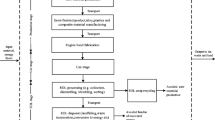Abstract
In this study, life-cycle comparisons of energy usage and CO2 emission of aluminum vs. conventional steel and the ultralight steel auto body were made for body-in-white applications at both the vehicle and fleet levels. The analysis considered three major stages of the life cycle: manufacturing, use, and recycling. The analysis also studied how life-cycle energy and emission benefits are affected by changes in input parameter values, such as manufacturing energy, vehicle-sales growth rate, secondary weight savings, fuel efficiency, and a lower aluminum replacement rate.
Similar content being viewed by others
References
J.L. Sullivan and J. Hu, “Life Cycle Energy Analysis for Automobiles,” SAE 951829 (Warrendale, PA: SAE, 1995).
K. Saur et al., Foundations for Life Cycle Analysis of Automotive Structures—The Potential of Steel, Aluminum and Composites, SAE 951844 (Warrendale, PA: SAE, 1995).
K. Martchek, S. Pomper, and J. Green, “Life Cycle Inventory Report for the North American Aluminum Industry—with Emphasis on Casting and Rolling” (Paper presented at Int. Conf. Casting and Rolling Technol., Baltimore, May 1999).
F. Stodolsky et al., “Life-Cycle Energy Savings Potential from Aluminum-Intensive Vehicles,” SAE Paper no. 951837 (Warrendale, PA: SAE, 1995).
J. Clark, Fleet-Based LCA: Comparative CO 2 Emission Burden of Aluminum and Steel Fleets (Cambridge, MA: Massachusetts Institute of Technology, 1999).
Review of the Research Program of the Partnership For A New Generation of Vehicles: Fifth Report (Washington, D.C.: National Academy Press, 1999).
G. Kobe, “Ford P2000,” Automotive Industries, 177 (April 1997), pp. 85–86.
Preliminary Report on the Consolidation of Life Cycle Inventory Data (London: International Primary Aluminum Institute, 1999).
J.L. Sullivan et al., “Life Cycle Inventory of a Generic U.S. Family Sedan: Overview of Results USCAR AMP Project,” SAE 982160 (Warrendale, PA: SAE, 1998).
S.T. Chubbs, personal communication with Sujit Das (1999).
S.C. Davis, Transportation Energy Databook: Edition 18, ORNL-6941 (Oak Ridge, TN: Oak Ridge National Laboratory, 1998).
S.-P. Miaou, Factors Associated with Aggregated Car Scrappage Rate in the United States: 1966–1992 (Oak Ridge, TN: Oak Ridge National Laboratory, 1995).
Energy Information Administration (EIA), Annual Energy Outlook 1999: With Projections to 2020, DOE/EIA-0383(99) (Washington, D.C.: U.S. Department of Energy, 1999); (also available at 〈website:www.eia.doe.gov/oiaf/aeo98/homepage.html〉.
Author information
Authors and Affiliations
Additional information
Editor’s Note: Although JOM style dictates the use of metric units of measure, the original units used in the analysis reported here have been retained to maintain the validity of the study.
For more information, contact S. Das, Oak Ridge National Laboratory, P.O. Box 2008, Bldg. 4500N, 1 Bethel Valley Road, Oak Ridge, Tennessee 37831-6205; (865) 574-5182; fax (865) 574-8888; e-mail dass@ornl.gov.
Rights and permissions
About this article
Cite this article
Das, S. The life-cycle impacts of aluminum body-in-white automotive material. JOM 52, 41–44 (2000). https://doi.org/10.1007/s11837-000-0173-2
Issue Date:
DOI: https://doi.org/10.1007/s11837-000-0173-2




